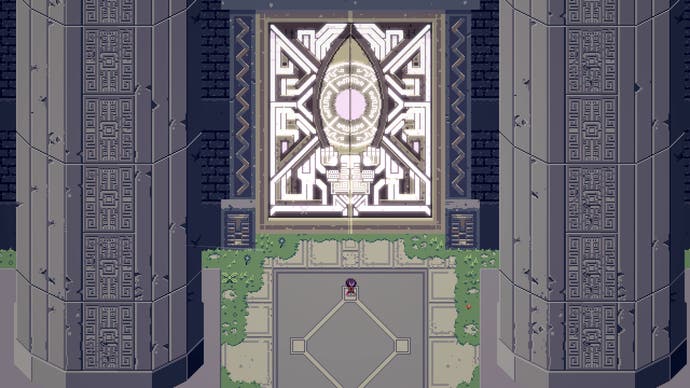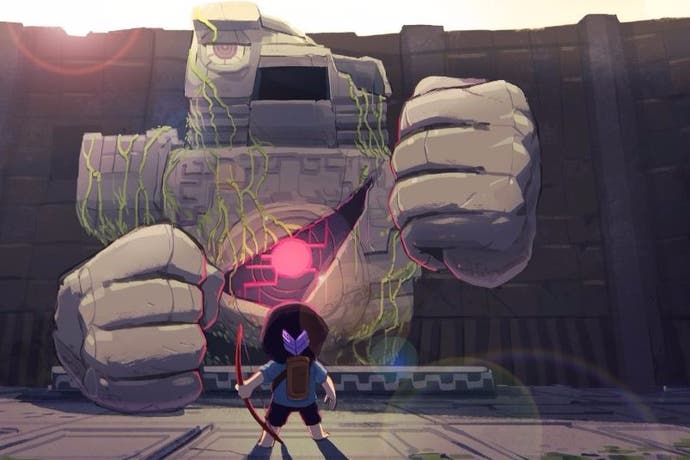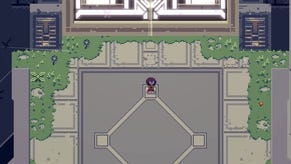Titan Souls review
One hit thrills.
In Titan Souls every strike is fatal. At a glance there appear to be no fair fights in these dainty hills and valleys, in the forsaken mountainsides and tombs. Your 15-pixel high warrior (assets: a crimson bow and a single arrow, a deft evasive roll and a purple bow to keep the hair from her eyes) must face off against towering stone giants, pulsating plants with spiked tendrils, mad yeti and monolithic statues with laser beam shooting eyes. And yet, a glancing blow from one of your arrows is just as deadly as anything these ancient monstrosities can level your way. Titan Souls is a series of fair fights then, despite appearances. It's a game of David and Goliath encounters in which fortune favours the slight and quick almost as often as it favours the colossus.
Titan Souls, which began as a game jam prototype from a trio of near-teenage friends, wears its inspirations openly. It's not so much influenced by Shadow of the Colossus, as a 2D cover version of Fumito Ueda's elegiac masterpiece. Both games present lush, unpopulated landscapes. Both games feature a youthful and seemingly underpowered roaming protagonist in search of a purpose. Both games require you to seek out a series of varied and wondrous foes, which are awakened by your presence and which can be fought and felled in any order. Both games eschew contemporary game design fashions (there's no character progression, no bow +1 to be salvaged, no giant-killing spells to be learned). As in Shadow of the Colossus, Titan Souls' rhythm is unusual and beguiling: long, peaceful treks across fields followed by intense and short-lived bursts of conflict, usually followed by feelings of relief and mild sadness.

The reference to Hidetaki Miyazaki's oeuvre, made so clearly in the 'Souls' adjunct, is in the high stakes encounters. Battles are, without exception, about creating a window of opportunity through which to fire an arrow at the foe's weak spot - be it a glowing eye, heart or, in the case of one foe, a pink bottom. Your arrow can wound in both directions: either as it flies from the string or as it's recalled to your side via magic, scraping along the ground as it zips back to its quiver. The boss characters pursue you unrelentingly and you must keep moving to evade their swipes, jabs or up-through-the-ground surges. One hurls rocks at you before diving into a frightfully quick forward roll towards your position. Another boss, a toothsome, anthropomorphic treasure chest, flaps its lid like a jaw, leaping into the air and landing, mouth open onto the ground in an effort to swallow you up (its weak spot is, naturally, accessible only when the lid is filly open).
This inexorable assault from each titan generates a tension as you can only ready and aim the arrow (or recall it) when stationary and, therefore, vulnerable. As such, you're constantly looking for the moment at which you have a few seconds' respite to aim and shoot. You won't have time to run to the optimum place to take the shot as well, so it's often a case of trying to manage the battle so you're in the right place when the momentary pause arrives. When you do finally manage to hit the target, the screen drains of colour and the action freeze frames in the millisecond of victory, only to be reawakened when you draw the arrow from the wound with a life-spurting pop.
A titan death usually comes suddenly and with an element of surprise: you frantically line up the shot hoping for the best, but when every decision must be made in an excruciatingly small window of opportunity, feelings of pride and self-satisfaction when the arrow strikes its intended target are usually tempered with a note of disbelief. The violence is quick and disturbing. There are no chipping health bars or Hollywood-esque builds of tension and release: it's a furious scramble for dominance, stressful, hurried and finally over in an instant.
For some, this will be the game's downfall. When every strike is deadly, the designers have to ramp up the difficulty (by closing down those windows of opportunity) to ensure that players don't blitz through the game. After the first handful of titans has been defeated, later specimens prove offputtingly aggressive. There is often no time to learn where you went wrong in learning an attack pattern, or divining exactly where and how to reach that vital weak spot. Another thing Titan Souls misses from Ueda's game is the unexpected feeling of emptiness and melancholy that followed the defeat of one of that game's giants. The colossi felt like ancient living creatures, and, as you brought them to their knees and, finally, their death, there were feelings of huntsman's regret. Here, where the titans die in an instant, there is no space to feel anything toward them except animosity and animal fear. The charred carcass each titan leaves on the ground after it is vanquished is a monument to victory but never loss. And when the game is so sparse elsewhere, mere feelings of victory aren't quite enough.
There is an admirable purity of vision here, one that it seems churlish to criticise when most other games could do with a truer sense of (and adherence to) their identity. And it would certainly be a mistake to characterise Titan Souls' sparseness of design as a lack of effort or artistry. See how the wind swirls around the trees; see how tufts of grass kick up as you sprint through fields; see how you leave padding footprints and lengthy roll-smears in the snow. This is a game built with love and thorough attention to detail. It is a startling debut for a young team who demonstrate an enviable clarity of design. But it falls short of greatness, perhaps because its main ingredients of hulking foes and one-hit kills cannot harmonise over the course of an entire adventure.
Our Titan Souls guide is live now if you need help to beat the game.





